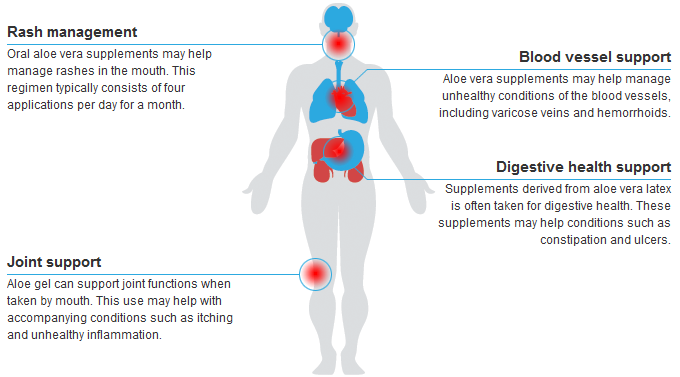Digestive Health
Aloe Vera Background and Benefits
 Aloe vera is a plant species with very short or no stems. It can grow up to one meter high and has thick leaves that are green or gray-green in color. The yellow flowers bloom in summer and grow on panicles that can grow up to a meter tall. The flower corollas grow up to one centimeter long.
Aloe vera is a plant species with very short or no stems. It can grow up to one meter high and has thick leaves that are green or gray-green in color. The yellow flowers bloom in summer and grow on panicles that can grow up to a meter tall. The flower corollas grow up to one centimeter long.
The natural distribution area of Aloe vera is probably North Africa and the Arabian Peninsula. However, this is difficult to determine due to extensive cultivation throughout the world. Aloe is often grown as an ornamental plant and for its medicinal properties. Aloe's succulent leaves thrive in low rainfall. Aloe vera does not tolerate hard frosts.
Aloe vera has been used in herbal medicine for at least 2,000 years. The leaves contain a milky sap and a gel, both of which are used for this purpose. The milky juice is a thin, yellow liquid, while the gel is a clear, jelly-like mass. The aloe vera extract contains many biologically active chemicals, especially the various polysaccharides.
Other bioactive compounds of Aloe vera include anthraquinones, anthrones, C-glycosides, lectins, acetylated mannans and polymannans.
Uses of Aloe Vera
Aloe medicines are commonly taken orally and applied topically. Oral uses of aloe vera include supporting digestive health, joint function, skin health, and blood vessel formation.

Signs that you may need aloe vera
Constipation is one of the clearest signs that you could benefit from taking aloe vera orally. Other digestive ailments such as stomach ulcers and ulcerative colitis may also indicate that you need aloe vera. Skin conditions such as rashes, itching and unhealthy inflammation are some of the most visible signs that you could benefit from aloe vera supplements. Less common reasons for taking aloe vera include respiratory problems and irregular menstrual cycles.






